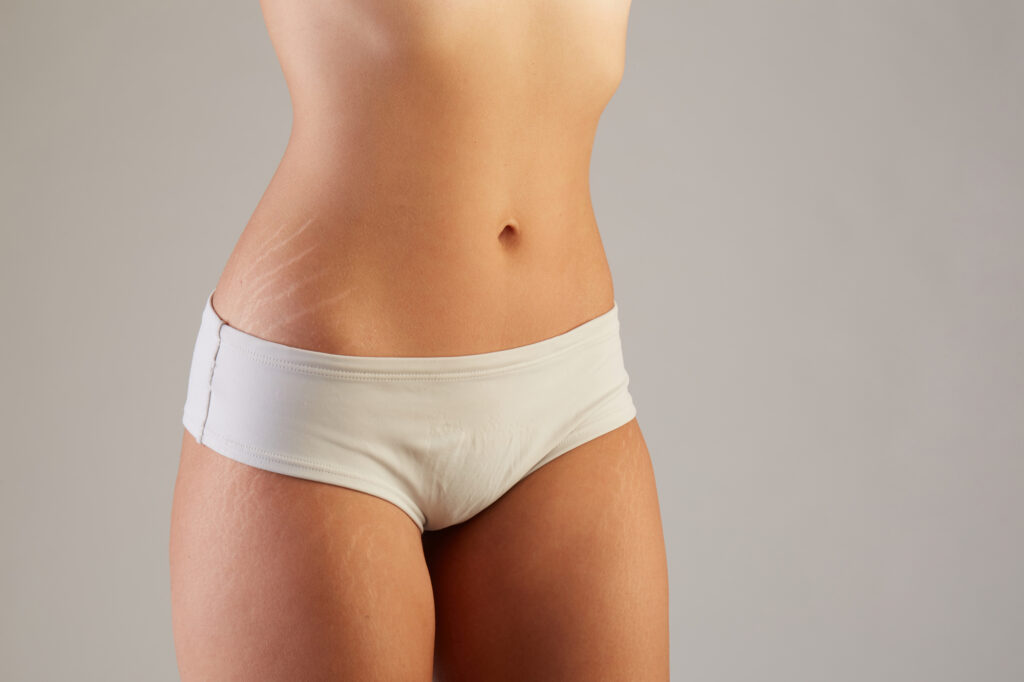
Many of us are familiar with the term stretch marks, whether we want to be or not! While these common skin discolorations are widely known to be associated with periods of rapid growth or change in our bodies, such as puberty, pregnancy, or significant weight fluctuations, the underlying process that leads to their formation is not as widely understood. Why do we get stretch marks? And what can we do about them?
Understanding Stretch Marks
So, what exactly are stretch marks? To understand this, we need to look beneath the surface of our skin. Skin is composed of multiple layers, with the outermost layer called the epidermis and a deeper layer known as the dermis.
The dermis is designed to stretch and rebound as our bodies grow and change. However, when the body grows too rapidly, it can cause a disruption in the production of collagen and elastin – proteins that are fundamental in providing support and elasticity to our skin. This sudden change leads to the tearing of the dermis, and as the skin heals, stretch marks may appear.
Stretch marks first appear as inflamed, bumpy skin that’s red or purple in color. As the healing process continues, they gradually fade to a whitish hue. Unlike some other types of scars, stretch marks tend to persist for a long time, and in many cases, they may never fade or completely disappear.
Risk Factors for Stretch Marks
While everyone can potentially develop stretch marks, certain factors may increase your likelihood. These include hormonal changes, genetic predisposition, and certain medical conditions.
If close family members have stretch marks, your chances of developing them may be higher. Furthermore, the long-term use of corticosteroids, which can thin the skin and reduce collagen, can also contribute to stretch mark formation.
Preventing Stretch Marks
Although it’s not always possible to prevent stretch marks entirely – particularly during life stages such as pregnancy or puberty – there are some steps that can be taken to minimize their likelihood. Maintaining a healthy weight, staying hydrated, and ensuring your diet includes adequate amounts of vitamins C, D, E, zinc, and protein can help keep your skin healthy and more resilient to rapid changes.
Treating Stretch Marks
Once stretch marks have formed, it can be challenging to remove them completely. Over-the-counter creams and lotions may promise fantastic results, but their effectiveness is often limited since stretch marks form in the deeper layers of the skin that these products can’t easily reach.
Thankfully, advancements in cosmetic procedures have provided us with more effective options than topical lotions and creams. But don’t worry, invasive surgical remedies are not necessary. These treatment options reach the deeper layers of the skin and get you noticeable, or even drastic, results. Depending on the location and severity of your stretch marks, treatment options include:
- Microdermabrasion– exfoliates the skin with a crystal-tipped wand to slough away dead skin cells and lessen discoloration.
- Chemical Peels– utilized a topical solution to deeply exfoliate, bringing newer cells to the surface and smoothing skin tone and texture.
- Microneedling– creates tiny injuries to the skin to promote natural healing, cell turnover, and collagen/elastin production.
- Laser Skin Resurfacing– light energy is used to break up hyperpigmentation deep within the skin.
Done With Your Stretch Marks?
At Radiance Med Spa, we understand that while stretch marks are a normal part of life, they can seriously affect self-confidence.
If you’re interested in learning more about stretch marks or exploring treatment options, we’re here for you. Contact us today to schedule a consultation – because you deserve to feel comfortable and confident in your skin.

